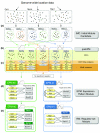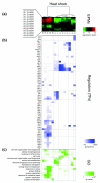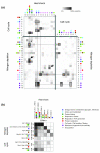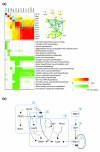High-resolution analysis of condition-specific regulatory modules in Saccharomyces cerevisiae
- PMID: 18171483
- PMCID: PMC2395236
- DOI: 10.1186/gb-2008-9-1-r2
High-resolution analysis of condition-specific regulatory modules in Saccharomyces cerevisiae
Abstract
We present an approach for identifying condition-specific regulatory modules by using separate units of gene expression profiles along with ChIP-chip and motif data from Saccharomyces cerevisiae. By investigating the unique and common features of the obtained condition-specific modules, we detected several important properties of transcriptional network reorganization. Our approach reveals the functionally distinct coregulated submodules embedded in a coexpressed gene module and provides an effective method for identifying various condition-specific regulatory events at high resolution.
Figures






Similar articles
-
Module networks: identifying regulatory modules and their condition-specific regulators from gene expression data.Nat Genet. 2003 Jun;34(2):166-76. doi: 10.1038/ng1165. Nat Genet. 2003. PMID: 12740579
-
Conservation and evolvability in regulatory networks: the evolution of ribosomal regulation in yeast.Proc Natl Acad Sci U S A. 2005 May 17;102(20):7203-8. doi: 10.1073/pnas.0502521102. Epub 2005 May 9. Proc Natl Acad Sci U S A. 2005. PMID: 15883364 Free PMC article.
-
Modularity of the transcriptional response of protein complexes in yeast.J Mol Biol. 2006 Oct 20;363(2):589-610. doi: 10.1016/j.jmb.2006.06.024. Epub 2006 Jul 3. J Mol Biol. 2006. PMID: 16973176
-
Computational discovery of gene modules and regulatory networks.Nat Biotechnol. 2003 Nov;21(11):1337-42. doi: 10.1038/nbt890. Epub 2003 Oct 12. Nat Biotechnol. 2003. PMID: 14555958
-
Power graph compression reveals dominant relationships in genetic transcription networks.Mol Biosyst. 2013 Nov;9(11):2681-5. doi: 10.1039/c3mb70236g. Mol Biosyst. 2013. PMID: 23963601 Review.
Cited by
-
Modeling regulatory cascades using Artificial Neural Networks: the case of transcriptional regulatory networks shaped during the yeast stress response.Front Genet. 2013 Jun 20;4:110. doi: 10.3389/fgene.2013.00110. eCollection 2013. Front Genet. 2013. PMID: 23802010 Free PMC article.
-
Reconstruction of regulatory networks through temporal enrichment profiling and its application to H1N1 influenza viral infection.BMC Bioinformatics. 2013;14 Suppl 6(Suppl 6):S1. doi: 10.1186/1471-2105-14-S6-S1. Epub 2013 Apr 17. BMC Bioinformatics. 2013. PMID: 23734902 Free PMC article.
-
Identifying a Transcription Factor's Regulatory Targets from its Binding Targets.Gene Regul Syst Bio. 2010 Dec 8;4:125-33. doi: 10.4137/GRSB.S6458. Gene Regul Syst Bio. 2010. PMID: 21245946 Free PMC article.
-
Dynamic reprogramming of transcription factors to and from the subtelomere.Genome Res. 2009 Jun;19(6):1014-25. doi: 10.1101/gr.084178.108. Epub 2009 Apr 16. Genome Res. 2009. PMID: 19372386 Free PMC article.
References
Publication types
MeSH terms
LinkOut - more resources
Full Text Sources
Molecular Biology Databases

